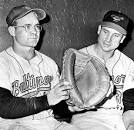A friend was over last night and I showed him my prized Sherm Lollar #10 1955 game-worn jersey. It’s in a glass case along with his worn, signature Rawling’s glove that pales in comparison to the 45” mitt worn by Baltimore Oriole’s catcher Clint Courtney in 1960 to better handler the knuckler of future Hall-of-Famer Hoyt Wilhelm. Courtney was back-up to Lollar for half the 1955 season before going to the Orioles while Wilhelm came to the White Sox in 1963, the year Lollar retired. I could find no evidence that they ever formed the same battery because Lollar only played in 35 games that final year of his career due to injury.
I also came across some interesting stats that prove how much the catcher matters to a pitching staff. A good example is that of future Hall of Famer, Yadier Molina, who while on the disabled list, St. Louis Cardinals starting pitchers had a combined 3-10 with an ERA above 5. The same is true as to why World Series Champion catcher Martin Maldonado remains in the Astros starting lineup despite a batting average of .151. Catchers should not necessarily be judged on their hitting.
Defensive skills, the ability to call a game and work with pitchers are incredibly important to a team’s success. It supports my argument as to why more catchers like Sherm Lollar, should be inducted into the Hall of Fame. His outstanding .992 fielding percentage, using the cumbersome gear of the era, supports the argument. Could a bigger glove have enhanced his chances or at least earned him more attention?
Clinton Dawson Courtney, nicknamed Scrap Iron, was an American professional baseball catcher who played in Major League Baseball for the New York Yankees, St. Louis Browns, Baltimore Orioles, Chicago White Sox, Washington Senators and Kansas City Athletics. He batted left-handed and threw right-handed. His oversized glove earned him notoriety. However, eventually MLB adopted a rule that restricted the size of a “Big Bertha” mitt like Courtney’s:
Rule 1.12: “The catcher may wear a leather mitt not more than thirty-eight inches in circumference, nor more than fifteen and one-half inches from top to bottom. Such limits shall include all lacing and any leather band or facing attached to the outer edge of the mitt. The space between the thumb section and the finger section of the mitt shall not exceed six inches at the top of the mitt and four inches at the base of the thumb crotch. The web shall measure not more than seven inches across the top or more than six inches from its top to the base of the thumb crotch. The web may be either a lacing or lacing through leather tunnels, or a center piece of leather which may be an extension of the palm, connected to the mitt with lacing and constructed so that it will not exceed any of the above mentioned measurements.”
The Sherm Lollar mitt in my collection measures less than 35” in circumference and is less than 11” from top to bottom. It’s well within the guidelines of this rule and ten inches smaller than Courtney’s. Meanwhile, “Old Sarge” Wilhelm, used primarily as a reliever, only had 52 career starts. Gus Triandos handled the catching duties in 32 of those games. Courtney got the assignment only 5-times, but “Big Bertha” also played a role in relief work during their two years together with the Orioles. Hail to the catchers!

Leave a Reply